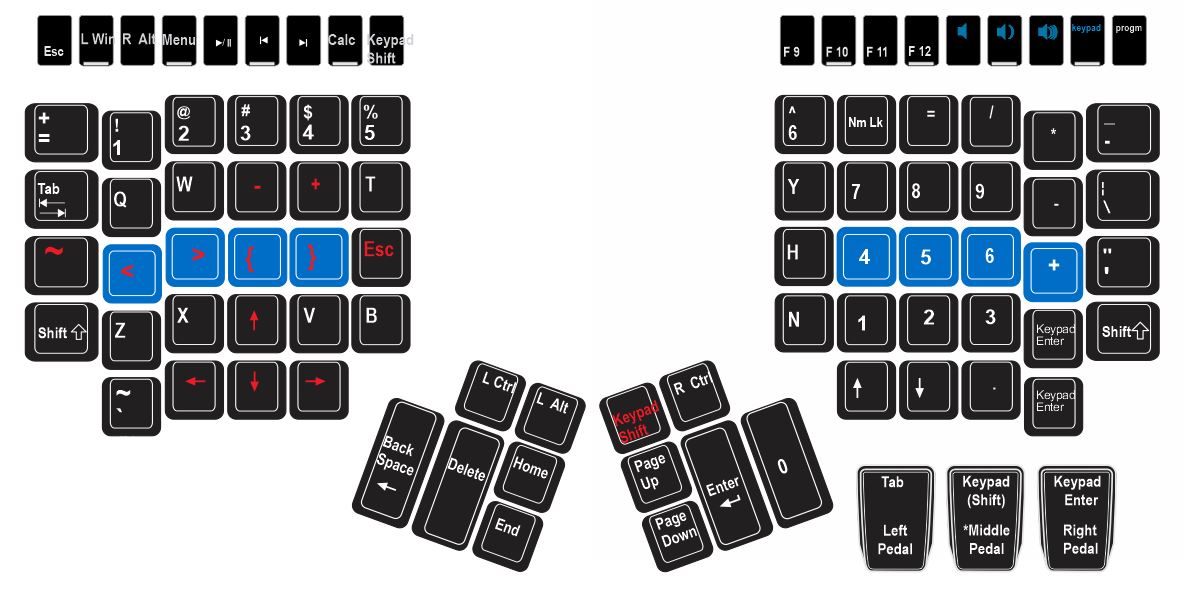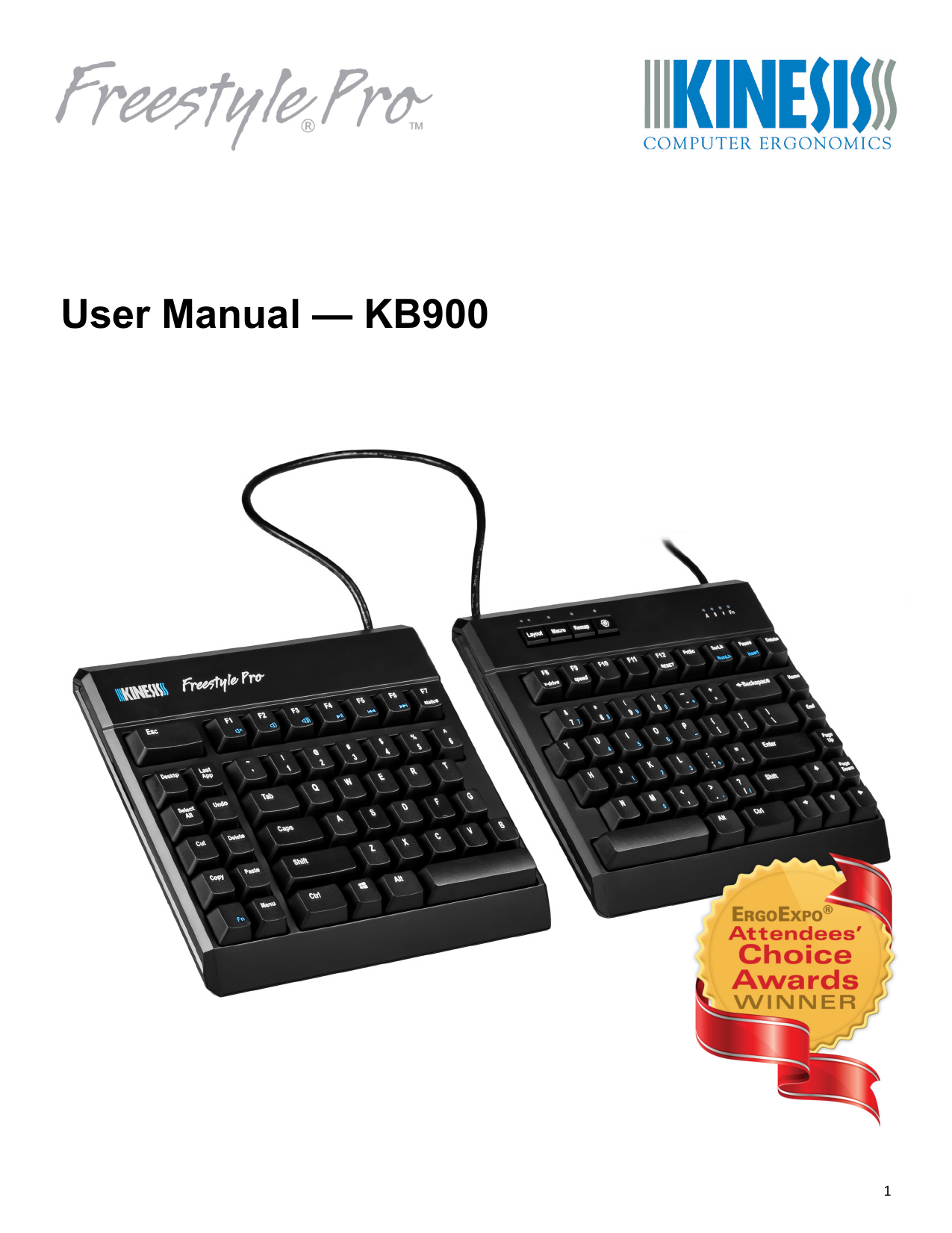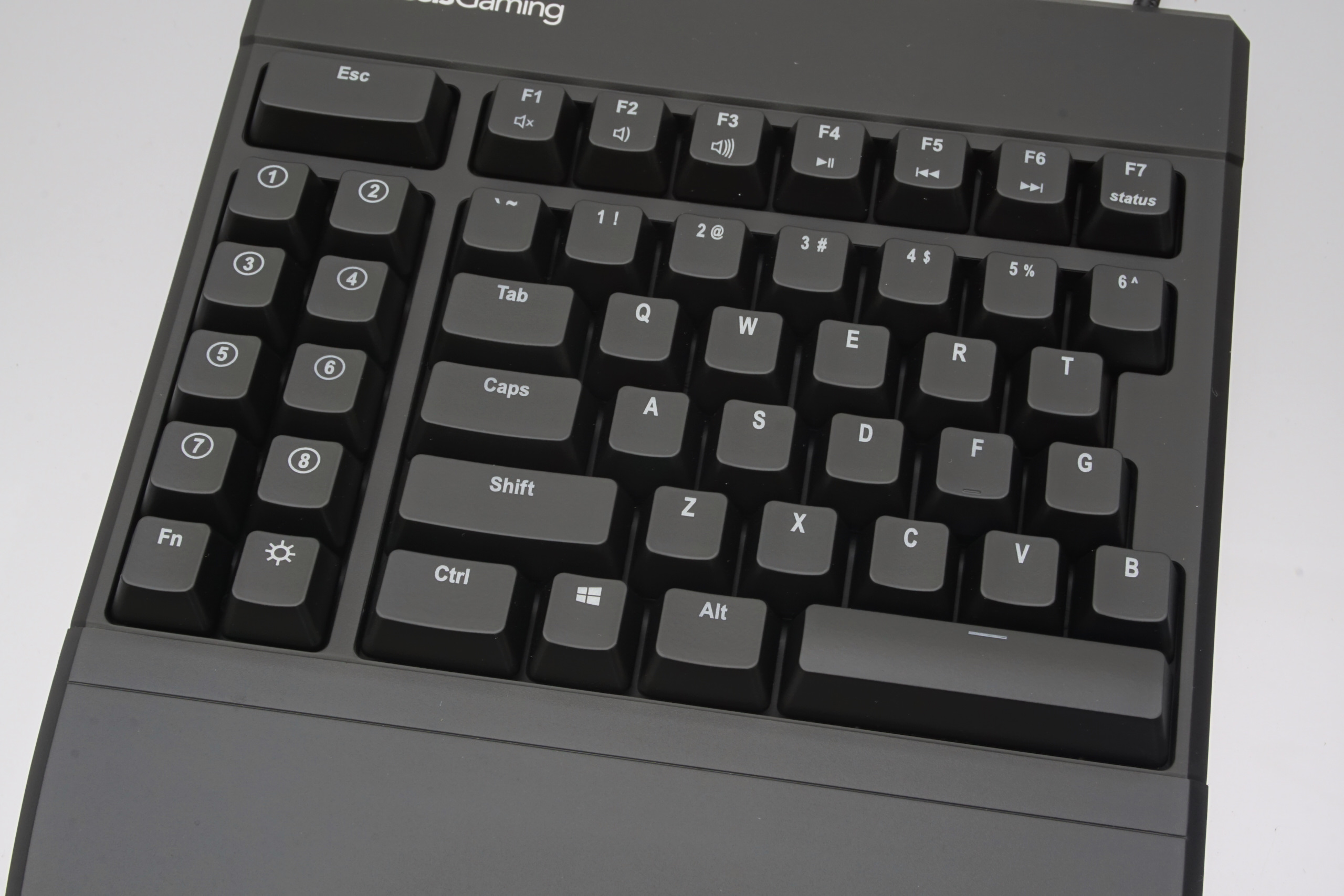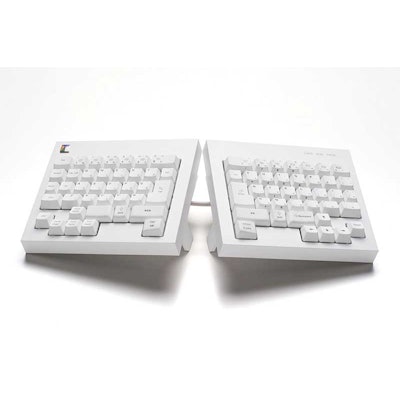- Kinesis Freestyle Program Keys For Sale
- Kinesis Freestyle Program Keys Pdf
- Kinesis Freestyle Program Keys
Kinesis Freestyle 2 Keyboard ‘Mod’ (to Fix Media Keys) 10 minute read Soon after I bought my Kinesis Freestyle 2 Keyboard, I noticed that the media keys (next/previous song) did not work with Spotify on OSX. The strange part is that they work just fine on iTunes. I decided to email the Kinesis tech support to see if they had a solution. May 11, 2021 The Drop ENTR is a simple mechanical keyboard, but its premium build makes it feel like so much more. Even better, its sub-$100 price means that you won't spend an extraordinary amount of money.
Soon after I bought my Kinesis Freestyle 2 Keyboard, I noticed that the media keys (next/previous song) did not work with Spotify on OSX. The strange part is that they work just fine on iTunes. I decided to email the Kinesis tech support to see if they had a solution.
Kinesis support was extremely quick to respond and informed me that this was a known problem and was fixed in the latest batch of keyboards. They offered to update the firmware on mine for free, but that required me sending them my keyboard (which is awesome!). I didn’t want to do that, so I figured, If they can update the firmware on this thing, so can I!
I had no knowledge of usb keyboards before I started, so the first thing I did was take the thing apart. (Well, one side of it, where all the controls are.) As usual, there was one extra hidden screw under a “Do Not Remove” tag.
Do Not Remove 'O.K.'
The keyboard itself has a few IC’s. The larger one is a Genesys Logic GL850G, which is a USB Hub. this makes sense, since there are two extra USB ports on the keyboard. The second one is an Alcor Micro AU9410 USB Keyboard Controller. Great, now I know what to look for!
After finding the data sheet for the controller, I started reading. The Alcor Micro guys were nice enough to include an example schematic, which included the pinout for the part. After reading some more, I realized there is an optional external EEPROM that can be used to change the controller’s configuration. This seemed like the perfect place to start probing.
AU9410 Reference Schematic
Unfortunately, the EEPROM is not labeled. On the other hand, the controller schematic states that it must be ‘a 24C08 or compatible’ part. Microchip makes one, so I found that data sheet. Time to start probing!
The keyboard designers left a nice 5 pin header unpopulated on the board. After some looking around, here’s the pinout I came up with:
1 - VCC2 - EEPROM Write Protect3 - I2C SCL4 - I2C SDA5 - GND
I used my Saleae Logic to take a look at what the keyboard does when it’s connected. The first it does after starting is read a whole lot of data from the EEPROM. After looking at the addresses, I noticed it was all the USB descriptor information. Including the device name, manufacturer, etc…
The next thing I tried was pressing on a key to see what happened. Turns out that whenever a key is pressed, the controller reads from the EEPROM every ~9ms or so. The address it reads from corresponds to the row and column on the keyboard. The value it reads is a four byte number. For example, when I press the letter ‘A’, it reads 00 00 04 04. The letter ‘G’ results in 00 00 0A 0A. The ‘next song’ and ‘previous song’ keys had slightly different codes 03 B5 00 40 and 03 B6 00 3E respectively.
'A' Press Capture (Single)
I wasn’t sure exactly what these numbers meant, so I started googling around. I ended up looking at the USB HID Usage Tables. In chapter 10, they have the Keyboard/Keypade codes. The letter ‘A’ is mapped to 0x04 and ‘G’ is mapped to 0x0A. Great, now I know what the numbers mean! Or not. Turns out the keyboard codes only go up to 0xE7. The rest (up to 0xFFFF) are reserved…
Initial Setup with Salae Logic
After some struggling, I ended up on the same document, this time in chapter 15 (Consumer Page). Looks like the ‘Usage ID’ 0xB5 is set for “Scan Next Track”. Perfect! I still don’t know what the rest of the bytes mean, but the 0xB5 means scan next track…
Now that I know what I need to change, I have to figure out how to do it. I took out my BusPirate and connected it to the I2C bus. Once it’s in I2C mode, you can dump the entire EEPROM using “[0xa0 0x00][0xa1 r:1025]”. I had to read an extra byte because the last one kept getting NACKed. Always make sure to backup your EEPROM data before modifying! For the curious, here are my EEPROMs contents:
Now that I have a backup of the data, time to start modifying they keys! But no, it didn’t work. I forgot to pull the write protect line low before attempting to write to the EEPROM. Now it works! As a first experiment, I reprogrammed the next song key with “[0xa6 0xA8 0x00 0x00 0x04 0x04]”. Immediately after, pressing the next song key produced ‘a’ characters. Perfect, now I can modify what any key does. (This could be the source of some nasty pranks… but I won’t go there today.)
Full Setup
So the current media key codes are broken… what should I change them to? I have no idea. I spend a good hour or two searching around, trying to figure out what the ‘correct’ code would be, with no luck. I started thinking about how I could brute force all codes until one worked. Fortunately, I didn’t have to. I went back to the USB HID Usage Tables and noticed the ‘Fast Forward’ and ‘Rewind’ keys, which had codes 0xB3 and 0xB4. Could it be that easy? Nah, there’s other bytes which are different in the current configuration. Lets try it anyway… So I programmed these values on the EEPROM: “[0xa6 0xA8 0x03 0xB3 0x00 0x40][0xa6 0xE0 0x03 0xB4 0x00 0x3E]”
Turns out it was that easy! The media keys work now. :) I have no idea what the last byte does, but changing it didn’t seem to affect the key function. So there you have it. Instead of sending my keyboard back for a firmware update, I spent the morning probing around and fixed it. Much more fun, not to mention educational! If there’s anyone else with this problem, I hope this helps!
This page shows you how to program the keys for theKinesis Advantage2 Keyboard.
Key Summary
- progm+F3
- Switch to QWERTY layout.
- progm+F4
- Switch to Dvorak layout. (All models of Kinesis Advantage2 have both Qwerty and Dvorak layout builtin.)
- progm+F5
- Switch to Mac mode.
- progm+F6
- Switch to PC mode.
- progm+F7
- Switch to Microsoft Windows mode.
- progm+F8
- Toggle key sounds. (When turning on, the scroll-lock light will flash 4 times. When turning off, it'll flash 2 times.)
- progm+Shift+F8
- Toggle special key on/off beep. (When turning on, the scroll-lock light will flash 4 times. When turning off, it'll flash 2 times.) When CapsLock is turn on, there's 2 beeps sound. When it's off, 1 beep. Similarly for Keypad, Num Lock, Scroll Lock.
- progm+F12
- Start/stop remap key.
- progm+F11
- Start/stop recording key macro.
- progm+status
- Paste text of current keyboard status. You must be in a text editor. For example, Microsoft Notepad, Mac TextEdit, etc.Sample output:
- progm+F10
- Toggle disable macro. (capslock LED will flash 4 times if disabling, 2 times if enabling.)
- progm+Ctrl+F9
- Hard Reset. It restore all defaults, and put current layout to QWERTY. Keep holding until LED stops flashing. Keyboard needs to be plugged in.
- progm+Shift+F9
- Soft Reset. Remove user's keymapping and macro definition of current active layout.
- progm+Shift+Escape
- Toggle Power User Mode. (All 4 LEDs flash 4 times on activation, 2 times on deactivation.) Note: if you have remapped Shift or Escape keys, you should press the remapped key.
- progm+F1
- Open or close the V-drive. (capslock LED will flash 4 times if opening, 2 times if closing.). Must be in power user mode first.
- progm+a
- Switch to or reload the variant “a” of the current active layout (“a_qwerty.txt” or “a_dvorak.txt”.).
- progm+b
- Switch to or reload the variant “b” of the current active layout.
- progm+c
- Switch to or reload the variant “c” of the current active layout.
- progm+Pause+1
- Set key macro playback speed to speed 1 (slowest).
- progm+Pause+2
- Set key macro playback speed to speed 2.
- progm+Pause+3
- Set key macro playback speed to speed 3.
- progm+Pause+4
- Set key macro playback speed to speed 4.
- progm+Pause+5
- Set key macro playback speed to speed 5.
- progm+Pause+6
- Set key macro playback speed to speed 6.
- progm+Pause+7
- Set key macro playback speed to speed 7.
- progm+Pause+8
- Set key macro playback speed to speed 8.
- progm+Pause+9
- Set key macro playback speed to speed 9 (fastest).

Remap Key
Suppose you want to make CapsLock do Ctrl.

- Hold progm then press F12. Release both.
- Press Ctrl, release, press CapsLock, release.
- Press progm again to stop.
Done. Now, pressing CapsLock will send Ctrl signal.
Do this to remap any key.
When you remap a key, key are based on their default meanings.So, you won't get into a confusing situation of recursive remaps.To make a key back to default, you can simply start remap and press that key twice.
Record Key Macro
Suppose you want to make F2 do Ctrl+c (copy).
- Hold progm then press F11. Release both. (numlock LED will flash fast continuously.)
- Press F2, release. (numlock LED will now flash slowly.)
- Press Ctrl+c.
- Press progm again to stop.
Done. Now, pressing F2 will do Copy.
The triggering key can be a key chord. For example, you can makeCtrl+kdo↓, so that when holding control, right hand keys can become arrow keys.
Erase One Key Macro
- Hold progm then press F11. Release both. (numlock LED will flash fast continuously.)
- Press the key or key combination that you want to erase. (numlock LED will now flash slowly.)
- Press progm again to stop.
Set Global Key Macro Playback Speed
- Press progm+Pause+1 (slowest)
- Press progm+Pause+2
- …
- Press progm+Pause+9 (fastest)
Power User Mode
- progm+Shift+Escape
- Toggle Power User Mode. (All 4 LEDs flash 4 times on activation, 2 times on deactivation.)Note: if you have remapped Shift or Escape keys, you should press the remapped key.
You need to be in Power User Mode to create a layout or mount the flash memory storage.
Create a Layout
steps to create a layout:

- Enter Power User Mode by pressing progm+Shift+Escape. (note: if you have remapped the Escape key or Shift key , you should press those keys.) (All 4 LEDs flash 4 times on activation, 2 times on deactivation.)
- Press progm+F2, then all LED lights will keep flashing.
- Press a letter key (for example, press x). LED lights will now stop flashing. This means, you have created a layout labeled “x”
- Done.
The newly created layout is a copy of the layout that was active at the time you created it. It includes all key remap and macro at the time. If you want to start fresh, do a Soft Reset first 【progm+Shift+F9】.
Kinesis Freestyle Program Keys For Sale
Press progm+status and you'll see the line “Current keyboard config file> x_dvorak.txt”.
Now, you can continue to create key remap or macro. They will be saved as part of the current layout.
Switch to a User Layout
• progm+a to switch and reload the variant “a” of the current active layout (“a_qwerty.txt” or “a_dvorak.txt”.).Similarly forprogm+b,progm+c,progm+d,etc.But you need to create it first.
When you switch to a layout, it will reload the corresponding config file stored in memory.
Open Flash Drive
- Enter Power User Mode by pressing progm+Shift+Escape. (note: if you have remapped the Escape key or Shift key , you should press those keys.) (All 4 LEDs flash 4 times on activation, 2 times on deactivation.)
- press progm+F1 to Open or close the V-drive. (capslock LED will flash 4 times if opening, 2 times if closing.).
Now, goto your OS's file viewer, and you can see the drive icon.(You might need to wait a few seconds before it shows up. On my linux box, I wait 4 seconds for my OS to automatically popup a window showing the mounted drive.)The drive is named “KINESIS KB”.or “ADVANTAGE2”
by default, there are these directories:
- active
- firmware
- System Volume Information
In the directory named “active”, you can open a layout file and edit it or email to friend.
The files“dvorak.txt”and“qwerty.txt” are the default.If you haven't created any key remap or macro, they are empty files.
If you have created layouts, you will see file named like these:
- “a_qwerty.txt”
- “b_qwerty.txt”
- “c_qwerty.txt”
- …
or
- “a_dvorak.txt”
- “b_dvorak.txt”
- “c_dvorak.txt”
- …
They are the layouts you created.
Edit Layout Config File
You can edit a layout config file directly and have keyboard reload it.
Just open the file in a text editor.
To reload the layout, just close the v-drive, by pressing progm+F1.
For example, here's my “d_dvorak.txt” file:
Here's the diagram of it:
switch to last app
Make End switch to last app.
Mac:
Microsoft Windows:
Shift Embedded Numberpad
Make End as shift for the embedded numberpad.
Make the Number Row Do Symbols
Key syntax
For the key syntax, best is to record a macro or remap keys. Then, when you open the layout file, you can see the key syntax used.
Letter keys are capitalized.
- key a, syntax
A - b
B - c
C
Number keys is itself.
- 0
0 - 1
1 - 2
2
Most punctuation keys is itself.
Except
- [ is
obrack - ] is
cbrack - - is
hyphen
Modifier keys:
lshiftlwin(also mean left ⌘ command)lctrlrctrlrshiftrwin(also mean right ⌘ command)raltlalt
More special keys:

entertabspacedelete→ Delete ⌦ (forward)bspace→ Backspacecaps→ CapsLockescapemenu→ the menu/apps context menu key.
homeendpup→ page uppdown→ page down
prtscr→ print screenscroll→ scroll lockpause→ pause keynumlk→ number lockcalc→ the calculator launcher keyshutdn→ the shutdown keyintl‐→ international key
Arrow keys:
leftrightupdown

Extra function keys not on keyboard:
F13F14F15F16
Keypad keys:
kp0kp1kp2kp3kp4kp5kp6kp7kp8kp9kp.→ keypad period keykpmin→ keypad minus keykppluskp=→ keypad equal sign key on the Mackp=mac→ keypad equal sign key on the Mackpmultkpenter→ the enter key on keypad
Multimedia keys:
next→ Next Trackprev→ Previous Trackplay→ playmute→ mutevol-→ volume downvol+→ volume up
Kinesis special keys:
kptoggle→ toggle number pad on/off.kpshift→ shift modifier to turn on number pad.
Kinesis Advantage2 Manual
Kinesis Freestyle Program Keys Pdf
Thanks to
- Thanks to Kinesis corp
- 2020-07-03 thanks to David Cole https://twitter.com/batchout/status/1278751694638264322
- 2020-07-03 thanks to aburadatw https://twitter.com/aburadatw/status/1278134437062959104
- 2020-07-03 thanks to Arjen Laarhoven https://twitter.com/ArjenL/status/1278394713897414657
Kinesis Freestyle Program Keys
see alsoKinesis Keyboard Layouts
back toKinesis Advantage2 Keyboard Review